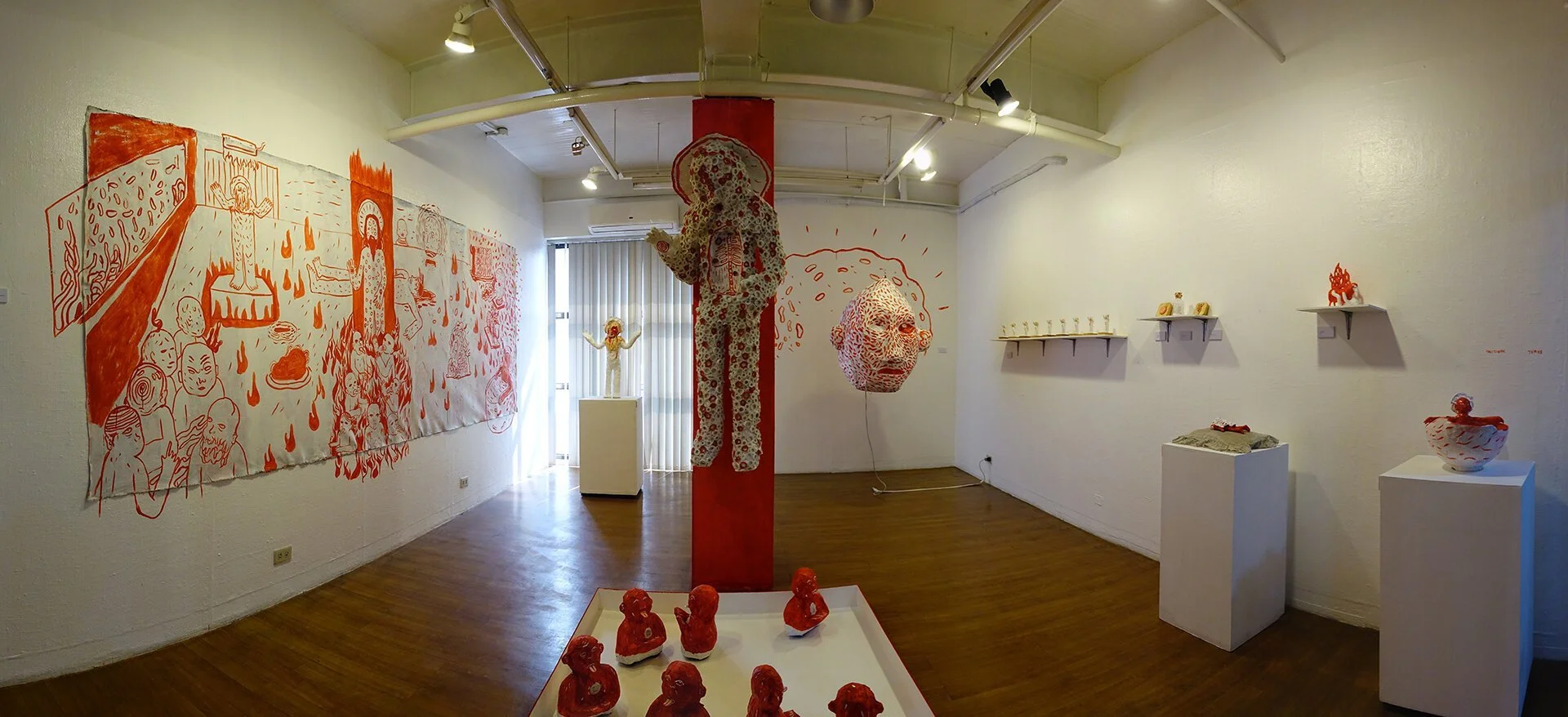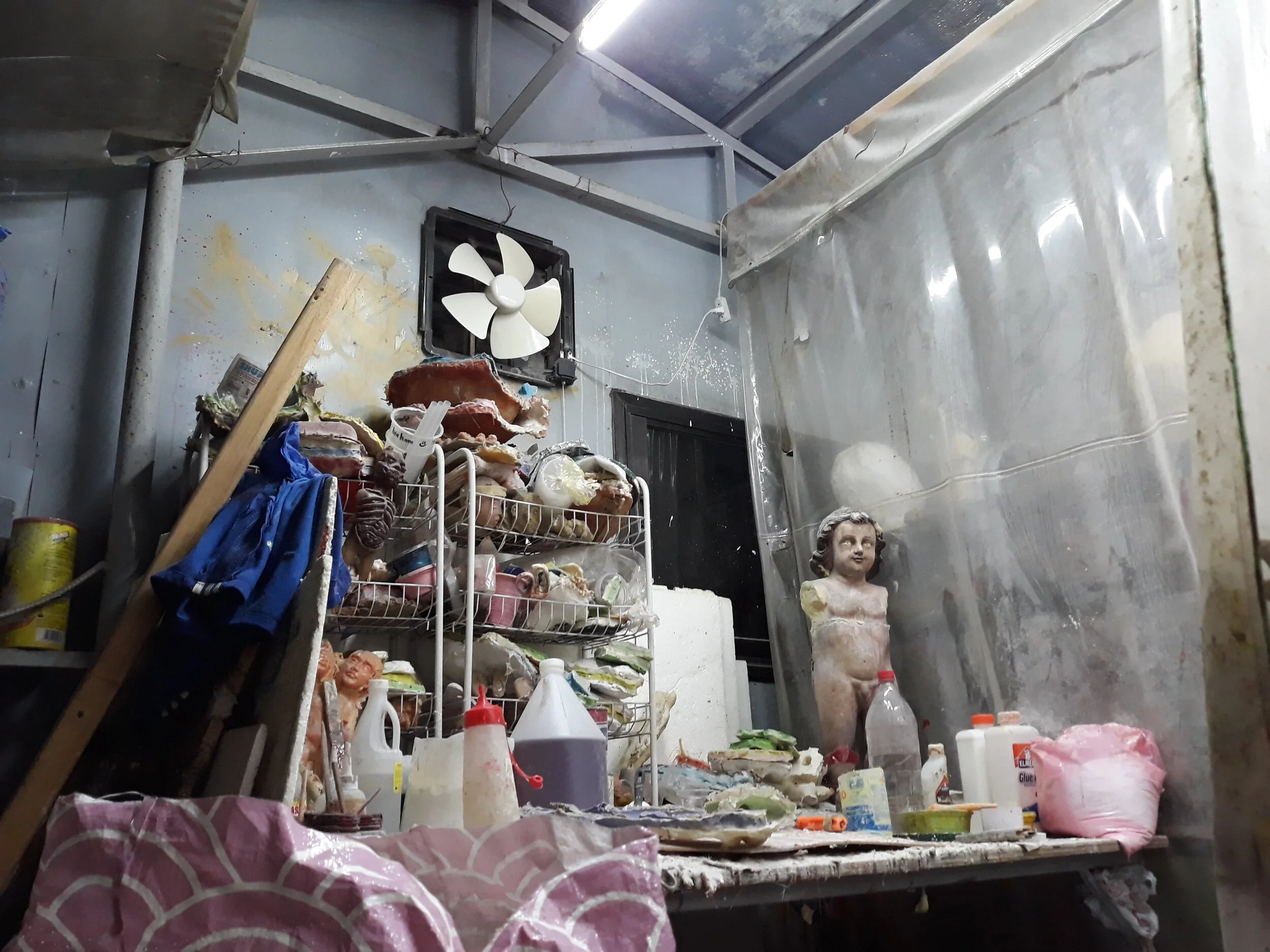Fresh Face: Doktor Karayom
Creating the macabre as catharsis
A&M's Fresh Face is where we profile an emerging artist from the region every month and speak to them about how they kick-started their career, how they continue to sustain their practice and what drives them as artists.
Doktor Karayom.
Filipino artist Russel Trinidad, publicly known by his moniker Doktor Karayom, is distinctly known for his artistic fixation on the colour red and the human anatomy. His art treads the line between fascination and disgust by distorting, disfiguring, and dismembering the physical body. Trinidad’s almost exclusive use of red captures the visceral nature of his work while compelling the audience to look closely into the social commentaries at play.
Doktor Karayom working in his studio space. Image courtesy of the artist.
Trinidad dove into the local art scene in the Philippines as a graffiti artist painting murals on abandoned buildings. As a Fine Arts student at the Technological University of the Philippines, he hid behind his street name ‘Doktor Karayom’ to avoid vandalism charges. After graduating, the artist worked as a graphic designer for a company based in Makati. It was at his office where he began doodling with a red ballpen. Outside of his corporate job, Trinidad restlessly developed his practice and gory art style. The artist continued his street art practice while holding solo exhibitions and fulfilling commissions for his red paintings and sculptures. Doktor Karayom started to garner local attention, receiving mainstream media coverage for his street art. He found success in art competitions, first winning a t-shirt design contest for a local fashion brand, and later the Ateneo Art Award in 2017 then the Thirteen Artist Award in 2018.
Installation view of Isla Inip (2018). Image courtesy of the artist.
Isla Inip (2018), an anagram for Pilipinas, earned Trinidad the prestigious Thirteen Artists Award by the Cultural Center of the Philippines at 27 years old as the youngest awardee in his cohort. The installation features an interactive board game that immerses viewers into a maze of Jose Rizal’s entrails. At the center lies the national hero’s 13-foot corpse, his flesh populated by tiny people. Trinidad’s crimson floor-to-ceiling illustrations and sculpture confront viewers with a harrowing truth about the nation’s collective psyche. The tiny figurines seem to be in a state of ‘inip’ or boredom, oddly unfazed by the rotting cadaver. The piece speaks to the farces and propagandistic narratives people believe to distract themselves from the grim realities of daily life in the Philippines, or in this case an ‘isla’ of martyrdom.
Doktor Karayom, Ang Paghiga sa Tinik ay Pagpatubo ng Bulaklak, 2021, 182.88 x 121.92 x 12.7cm, wood, resin, fiberglass and spray paint. Image courtesy of the artist.
Doktor Karayom has had a consistent lineup of exhibitions since his first solo show Santong Pikon! (2015), including Habak (2020) at Artinformal Gallery. Habak is a reference to a Visayan amulet passed down from ancient Philippine warriors who wore them for invincibility at war. In the Philippines today, elderly mystics wear habak around their hips to fend off evil. Trinidad’s exhibition makes these waging invisible wars of spirit versus amulet tangible on canvases festering with resin sculptures of eyes, faces, and bloody figures catching fire. However, the artist does not intend for these depictions to strike fear, but to give strength and protection to all who see his work.
Ultimately, Doktor Karayom’s use of the macabre funnels the all of the inner physical, emotional, and spiritual turmoil we face into outward pain. This gory bacchanalia depicting wounded and mangled bodies evokes strong reactions from the audience as an cathartic release.
Interview
Doktor Karayom, KARAYOMDUGYOTFACE, 2021, acrylic paint, resin and epoxy on canvas, 182 x 122cm. Image courtesy of the artist.
How did you come up with your alias ‘Doktor Karayom’?
My name is Doktor Karayom. ‘Karayom’, which translates to needle, comes from the Filipino saying “kahit butas ng karayom, papasukin ko” or “I will pass through the eye of a needle to achieve my dreams''. I chose the word KARAYOM because I wanted my creations to convey emotion to my audience. I want my work to be able to be both medicine and poison, anesthetic and narcotic, tranquilizer and euphoriant. In my perspective, each piece is meant to confront different types of feelings and illnesses. Then, I added the title ‘DOKTOR’ as a tribute to the many doctor characters I have seen in the horror movies, scary stories, and supernatural tales from which I take inspiration.
Could you share how you’ve maintained your practice after graduation? What are the important factors that kept you going?
After graduating from Technological University of the Philippines (TUP), I made the decision to become an artist, but I didn’t know how to reach that goal. Therefore, I became an apprentice to Dex Fernandez, a fellow Filipino artist and one of my role models. From him, I learned how to make a living as an artist. I took on additional opportunities such as becoming a Wacom Pen Tablet promoter at the mall and taking on street art projects. Then I took on a full time job at an office where I learned the inner workings of the company. Even when I was working full time, I was determined to continue making art.
Installation view of SANTONG PIKON! (2015). Image courtesy of the artist.
How did the opportunity for your first solo show, SANTONG PIKON! (2015) at West Gallery of the Philippines come about?
At first, it was nerve wracking because it was my first solo exhibition, but I’m sure that’s how everyone who has been in my position has felt. I couldn’t remember if there was an artist who backed out. I just remember Dex Fernandez came to me and said something along the lines of, “There, go do your solo show”. When I agreed, I felt a mixture of anxiety and excitement because it was different from the group shows I had participated in up till then. This time, I was all by myself. I would have to hone in on the theme and the story I could tell in the exhibit.
I am so grateful to West Gallery and especially to Sir Soler Santos for his willingness to exhibit my first show in their space.
What was the process like preparing for it?
I first thought of the budget for the materials that I wanted to use because I wasn’t making much money back then. Then, I also found a way to use available materials from my immediate environment.
At the time, I used my breaks in the office to work on pieces for the exhibition. And when I went home from the office, I would continue to work on the piece and would not stop until I was satisfied. Despite the long hours, I was surprised with what I was able to accomplish.
Since the exhibition, invitations to showcase my art have continued to come my way.
Doktor Karayom, Mata sa Loob ng Pikit na Panalangin, 2021, 182.88 x 121.92 x 12.7cm, wood, resin, fiberglass and spray paint. Image courtesy of the artist.
How does your use of the color red and grotesque imagery and shed light on larger societal issues?
Red is a striking color. The color helps me tell my stories. This is the color of remembrance, emphasis, or warning. I embrace the terrifying imagery this color evokes because it is the color of blood and internal organs.
Your recent exhibition Habak (2021) at Artinformal Gallery consists of 3D mixed-media installations and resin sculptures. Could you talk about the ideas and process behind this show?
Habak (2020) was probably the most time-consuming exhibition I have put together, it took almost a year of preparation. There were so many times where I made mistakes, took things apart, put them back together and thought of the right approach to finish a piece. There were many times where I felt frustrated, and I even broke down in front of the piece while I was creating it. This was the piece that I confronted back when the lockdown first started in the Philippines. Preparing for the show took over my life. The work kept me in the right headspace even while there were many things happening around me. I was overwhelmed but I was able to express what I was feeling into the piece.
Habak is a Visayan term for an amulet or a charm that is worn on the body. It contains different contents of branches, leaves, herbal medicine, oil, prayers, etc. This was protection to fight against harmful elements around us. While I was making this work, I think I was protected by it because of the heavy feelings I felt. I also included a spell where whoever sees this or whoever possesses it may be given protection and guidance from the unseen evils.
I am grateful to Artinformal gallery, Ms. Tina Fernandez and Sir Norman Crisologo who helped materialize my imaginations and vision for the exhibition.
Who has been a mentor or an important artistic influence? And why?
I had many influences when I was just starting, when I was still searching for myself as Doktor Karayom. From the start, my mentors at the Philippines Street Plan, the first street art graffiti crew in the country, influenced my art practice and journey. The people I have lovingly called kuya, ate or tito1 have not only impacted my graffiti art in the streets but also my fine art inside galleries.
I owe a big debt of gratitude to Dex Fernandez/Garapata who has been a great mentor to me. I was also heavily impacted by TUP Alumni and their artist networks because they were the ones who believed in who I could become since college. I am also very grateful for Cavity Collective because they influenced me in aspects other than art. They were there for me when becoming an artist was just a dream, when we didn’t even know what would happen from the paintings we would make in the streets as well as the early group shows we would host. Even now, I am still with them. I am also thankful to all of the friends I made in the art scene who supported my personal growth and developed my creative process.
Doktor Karayom’s studio space. Image courtesy of the artist.
What was one important piece of advice you were given?
All of the galleries I’ve encountered have been nice and easy going. I’m very grateful some of them have accepted my artworks and given me the space to experiment and be guided by my mischief.
What are your hopes for your own local art scene, and regionally as well?
I hope that they give recognition to more obscure talents in the Philippine art scene. I also hope that it continues to grow and expand its horizons so they could be known in our neighboring countries and eventually the other side of the globe.
Are there any upcoming exhibitions/projects that you would like to share more information on?
I am working on some projects for the upcoming exhibit and other artistic ventures. I give regular updates on my Instagram account (@doktorkarayom).
MARAMING SALAMAT PO!








